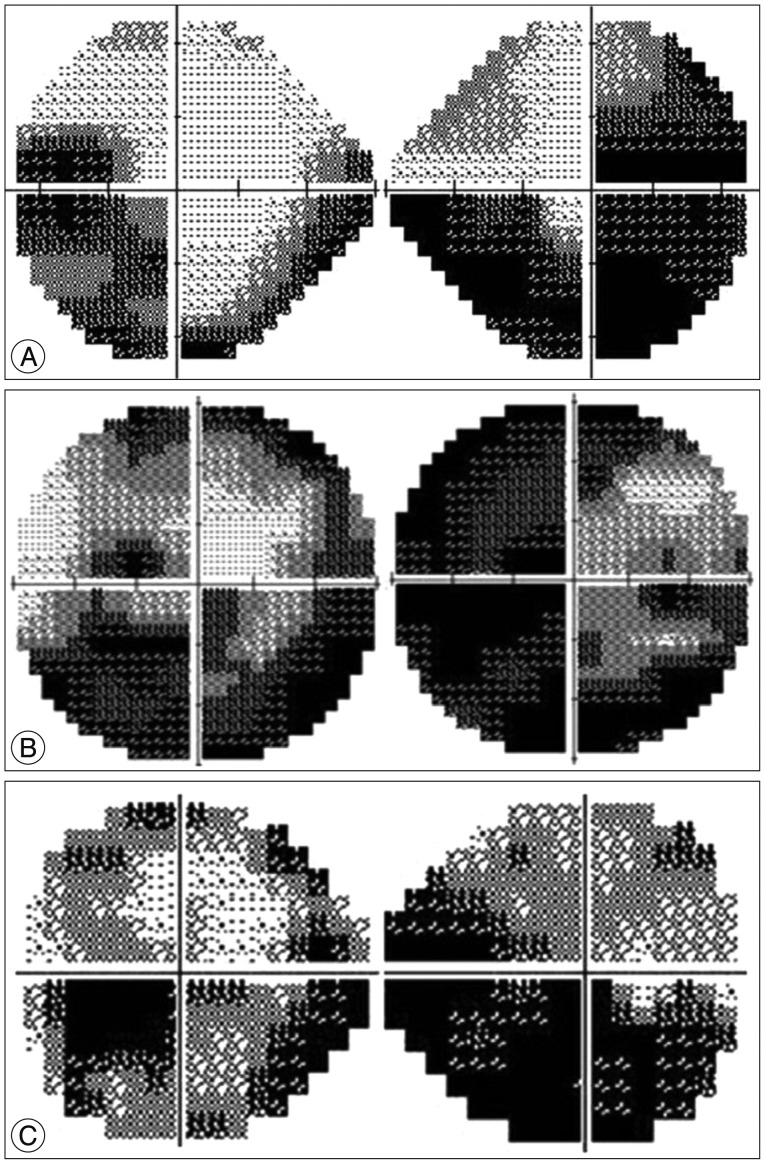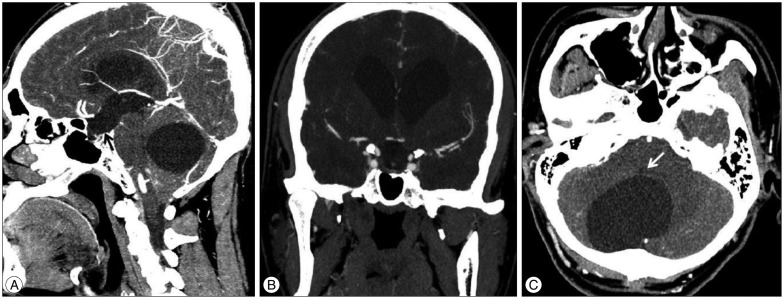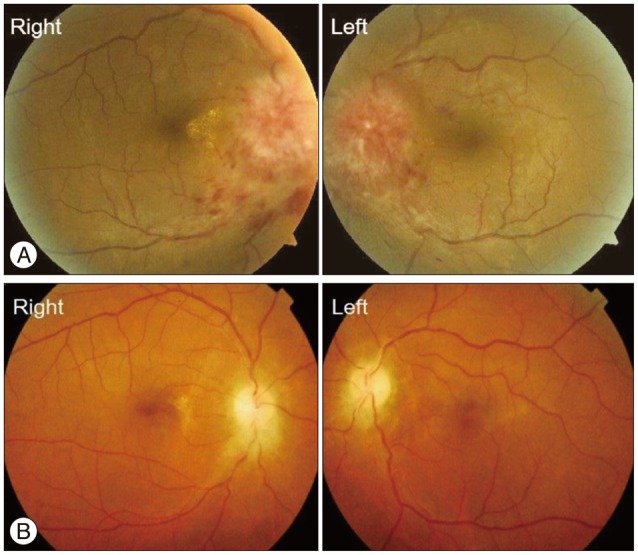Abstract
Posterior fossa is a site next to the middle fossa where arachnoid cyst frequently occurs. Generally, most arachnoid cysts are asymptomatic and are found incidentally in most cases. Although arachnoid cysts are benign and asymptomatic lesions, patients with posterior fossa arachnoid cysts often complain of headaches, gait disturbance, and ataxia due to the local mass effects on the cerebellum. We observed a patient with a posterior fossa arachnoid cyst who had visual symptoms and a headache, but did not have gait disturbance and ataxia. We recommended an emergency operation for decompression, but the patient refused for personal reasons. After 7 days, the patient revisited our hospital in a state of near-blindness. We suspected that the arachnoid cyst induced the hydrocephalus and thereby the enlarged third ventricle directly compressed optic nerves. Compressed optic nerves were rapidly aggravated during the critical seven days; consequently, the patient's vision was damaged despite the operation. Considering the results of our case, it is important to keep in mind that the aggravation of symptoms cannot be predicted; therefore, symptomatic arachnoid cysts should be treated without undue delay.
Arachnoid cysts are benign, non-neoplastic and extra-axial lesions; most of them are clinically silent and unchanged in size. In previous studies112131524), the incidence of arachnoid cysts has been estimated to range between 0.3% to 1.7%. However, the advanced neuroimaging techniques have facilitated the diagnosis of arachnoid cysts, which, in turn, has led to an increase in the number of patients2121415).
In some cases, an arachnoid cyst arouses symptoms and its clinical presentations vary according to the size and location of the cyst. The most frequent symptom is headache, which is caused by the local mass effect, increased intracranial pressure (ICP), and/or hydrocephalus15). Above this, seizures, cognitive dysfunction, developmental delay, and intracranial hemorrhage can be also presented.
In this report, we describe a case where a patient with a posterior fossa arachnoid cyst complained of visual field defect, visual disturbance, and mild headache; no ataxia and unsteady gait were reported. The patient's visual symptoms rapidly deteriorated in a week and, consequently, the patient's vision got worse.
A 39-year-old male patient presented at our emergency room after a traffic accident and the brain computed tomography (CT) scan indicated an incidental arachnoid cyst on posterior fossa. At that time, the patient complained only of facial abrasions and the left knee pain, but not of headache or visual disturbance. In eight months, however, he revisited our Department of Ophthalmology to check the decreased visual acuity, visual field defect, and headache. On the ophthalmologic examination, bilateral papilledema (Fig. 1A), decreased visual acuity, and visual field defect (Fig. 2A) were found. After the transfer to the Department of Neurosurgery, we rechecked brain CT scans (Fig. 3). The diameter of the patient's arachnoid cyst did not change compared to the previous CT scans; however, the slightly enlarged third ventricle was compressing the optic chiasm and the suprasellar area. Since visual complications were expected, we recommended an emergency operation. However, the patient refused the operation for personal reasons. One week later, he came back to the hospital with nearly complete visual loss. His right eye was completely blind, whereas his left eye recognized only light (Fig. 2B).
On that day, he underwent an emergency operation. A conventional suboccipital craniectomy was performed on the patient lying on the operating table in the prone position. After the dural incision, the arachnoid cyst was exposed and cystic fluid was expelled. Arachnoid membrane was carefully dissected and the arachnoid cyst was fenestrated to cisterna magna for connecting with the cerebrospinal fluid (CSF) flows. Arachnoid membrane which covering the foramen of magendie was also fenestrated and the CSF flows was running properly (Fig. 4). Excluding the brain tumor, the collected membrane was sent to the pathologic laboratory. In high power field microscopy under the hematoxylin and eosin stain, the cystic membrane was composed by membranous fibrocollagenous tissues without tumor cells. Finally, the patient was diagnosed as arachnoid cyst (Fig. 5).
One week afterwards, we checked the brain CT scans and the removal of the cyst and the decreased ventricle size were confirmed. On the ophthalmologic examination, the papilledema and visual field were slightly improved; however, the patient's visual acuity did not improve. Upon the tenth day after the operation, the patient was discharged and, during the next one month, he was subject to the steroid therapy.
In five months after the operation, papilledema (Fig. 1B), headache, and radiological images (Fig. 6) quickly returned to the normal ranges. Nevertheless, visual acuity and visual field improved slowly and slightly (Fig. 2C). The blind right eye improved to recognize the light and the blurred left eye improved to acknowledge the silhouette of an object; thus, it did not fully recovered to the prior, normal condition.
Arachnoid cysts are benign, non-neoplastic and extra-axial lesions. Their prevalence has been reported to amount to approximately 1% of all intracranial mass lesions112152430); however, advanced neuroimaging techniques and the widespread use of CT and MRI imaging have led to an even higher incidence of report of these lesions1249121619203031). One recent study, Al-Holou et al.1), reviewed 48417 brain images and identified 661 (1.4%) arachnoid cysts. This report found that the prevalence of arachnoid cyst in children was 2.6%, slightly higher than in adults, and men (1.8%) have a high prevalence than women (1.1%). The most common locations were middle fossa (34%), retrocerebellar (33%), and cerebral convexity (14%)124). Despite the increased identification of arachnoid cysts, the natural history and mechanism of enlargement has not been well defined1131524).
Most arachnoid cysts are asymptomatic and are found incidentally in most cases1112429). Nevertheless, when arachnoid cysts give rise to any symptom, headache is the most common complaint. This symptom is caused by the local mass effect and hydrocephalus. In addition to headache, gait imbalance, seizure, and visual changes can also be presented according to the location and size of the arachnoid cyst. If clinical symptoms develop, surgical interventions are recommended3615162122232728). Various operation techniques, such as cyst excision1517), stereotactic aspiration1825), endoscopic cyst fenestration512), ventriculocystostomy26), and cystoperitoneal shunt810152728), have been introduced and the main purpose of such operations is similar, namely, a direct decompression of the arachnoid cyst or making the connection between the cyst and the CSF flows for spontaneous resolution.
Generally, visual symptoms occur in the patients with suprasellar arachnoid cysts, because the arachnoid cyst is adjacent to the optic nerves7). The patients with posterior fossa arachnoid cysts usually do not complain of visual symptoms, as the cyst is not adjacent to the optic nerves. However, a posterior fossa arachnoid cyst can indirectly disrupt the CSF flows and, in turn, the disruption increases the whole ventricle size and the ICP. In our case, the enlarged third ventricle was compressing the optic chiasm with cephalocaudal direction on the CT scan (Fig. 3A, B). The compressed superior part of optic chiasm led to the defect of inferior visual field (Fig. 2). In addition, visual acuity was affected by the papilledema, which was caused by the increased ICP. Consequently, both visual acuity and visual field were influenced by the posterior fossa arachnoid cyst.
When the patient first visited our Department of Ophthalmology, his visual symptoms and headache were not severe and the patient could walk and drive. Besides, the brain CT scan showed no changes as compared to previous CT scans, so we could not predict a risk of rapid deterioration. The patient's refusal to have an operation and the surgeon's wrong prediction delayed the appropriate on-time treatment; ultimately, the patient's vision was severely damaged during the critical seven days. After the operation, the patient's visual acuity, visual field, and papilledema were slightly improved; however, we regard that the patient's vision will unfortunately not fully recover.
Unlike gait disturbance and ataxia, visual symptoms do not frequently occur in the patients with posterior fossa arachnoid cysts; this is so because the cyst is located away from the optic nerves. However, the disruption of CSF flows can indirectly induce visual symptoms and these symptoms can rapidly deteriorate.
Considering the results of our case, it should be emphasized that the patients with posterior fossa arachnoid cysts could develop a rapid neurologic deterioration. Furthermore, the aggravation pace of the symptoms can be neither estimated nor predicted. Therefore, in the event of the development of symptoms, an early intervention or close observation are crucial.
References
1. Al-Holou WN, Terman S, Kilburg C, Garton HJ, Muraszko KM, Maher CO. Prevalence and natural history of arachnoid cysts in adults. J Neurosurg. 2013; 118:222–231. PMID: 23140149.

2. Al-Holou WN, Yew AY, Boomsaad ZE, Garton HJ, Muraszko KM, Maher CO. Prevalence and natural history of arachnoid cysts in children. J Neurosurg Pediatr. 2010; 5:578–585. PMID: 20515330.

3. Arai H, Sato K, Wachi A, Okuda O, Takeda N. Arachnoid cysts of the middle cranial fossa : experience with 77 patients who were treated with cystoperitoneal shunting. Neurosurgery. 1996; 39:1108–1112. discussion 1112-1113. PMID: 8938764.
4. Banna M. Arachnoid cysts on computed tomography. AJR Am J Roentgenol. 1976; 127:979–982. PMID: 998837.

5. Caemaert J, Abdullah J, Calliauw L, Carton D, Dhooge C, van Coster R. Endoscopic treatment of suprasellar arachnoid cysts. Acta Neurochir (Wien). 1992; 119:68–73. PMID: 1481755.

6. Choi JU, Kim DS, Huh R. Endoscopic approach to arachnoid cyst. Childs Nerv Syst. 1999; 15:285–291. PMID: 10461776.

7. Choi KY, Jung S, Kang SS, Kim IY, Jung TY, Jang WY. Technical considerations to prevent postoperative endocrine dysfunction after the fenestration of suprasellar arachnoid cyst. J Korean Neurosurg Soc. 2011; 49:262–266. PMID: 21716897.

8. Ciricillo SF, Cogen PH, Harsh GR, Edwards MS. Intracranial arachnoid cysts in children. A comparison of the effects of fenestration and shunting. J Neurosurg. 1991; 74:230–235. PMID: 1988593.

9. Eskandary H, Sabba M, Khajehpour F, Eskandari M. Incidental findings in brain computed tomography scans of 3000 head trauma patients. Surg Neurol. 2005; 63:550–553. discussion 553. PMID: 15936382.

10. Fewel ME, Levy ML, McComb JG. Surgical treatment of 95 children with 102 intracranial arachnoid cysts. Pediatr Neurosurg. 1996; 25:165–173. PMID: 9293543.

11. Galassi E, Tognetti F, Frank F, Fagioli L, Nasi MT, Gaist G. Infratentorial arachnoid cysts. J Neurosurg. 1985; 63:210–217. PMID: 4020444.

12. Gangemi M, Seneca V, Colella G, Cioffi V, Imperato A, Maiuri F. Endoscopy versus microsurgical cyst excision and shunting for treating intracranial arachnoid cysts. J Neurosurg Pediatr. 2011; 8:158–164. PMID: 21806357.

13. Halani SH, Safain MG, Heilman CB. Arachnoid cyst slit valves : the mechanism for arachnoid cyst enlargement. J Neurosurg Pediatr. 2013; 12:62–66. PMID: 23662935.

14. Hanieh A, Simpson DA, North JB. Arachnoid cysts : a critical review of 41 cases. Childs Nerv Syst. 1988; 4:92–96. PMID: 3401876.
15. Harsh GR 4th, Edwards MS, Wilson CB. Intracranial arachnoid cysts in children. J Neurosurg. 1986; 64:835–842. PMID: 3701434.

16. Helland CA, Wester K. A population-based study of intracranial arachnoid cysts : clinical and neuroimaging outcomes following surgical cyst decompression in children. J Neurosurg. 2006; 105(5 Suppl):385–390. PMID: 17328263.

17. Hinojosa J, Esparza J, Muñoz MJ, Valencia J. [Endoscopic treatment of suprasellar arachnoid cysts]. Neurocirugia (Astur). 2001; 12:482–488. discussion 489. PMID: 11787396.
18. Iacono RP, Labadie EL, Johnstone SJ, Bendt TK. Symptomatic arachnoid cyst at the clivus drained stereotactically through the vertex. Neurosurgery. 1990; 27:130–133. PMID: 2198483.

19. Katzman GL, Dagher AP, Patronas NJ. Incidental findings on brain magnetic resonance imaging from 1000 asymptomatic volunteers. JAMA. 1999; 282:36–39. PMID: 10404909.

20. Kim BS, Illes J, Kaplan RT, Reiss A, Atlas SW. Incidental findings on pediatric MR images of the brain. AJNR Am J Neuroradiol. 2002; 23:1674–1677. PMID: 12427622.
21. Levy ML, Meltzer HS, Hughes S, Aryan HE, Yoo K, Amar AP. Hydrocephalus in children with middle fossa arachnoid cysts. J Neurosurg. 2004; 101(1 Suppl):25–31. PMID: 16206968.

22. Levy ML, Wang M, Aryan HE, Yoo K, Meltzer H. Microsurgical keyhole approach for middle fossa arachnoid cyst fenestration. Neurosurgery. 2003; 53:1138–1144. discussion 1144-1145. PMID: 14580280.

23. Oberbauer RW, Haase J, Pucher R. Arachnoid cysts in children : a European co-operative study. Childs Nerv Syst. 1992; 8:281–286. PMID: 1394268.
24. Panigrahi S, Mishra SS, Das S, Patra SK, Satpathy PC. Large intradural craniospinal arachnoid cyst : a case report and review of literature. J Craniovertebr Junction Spine. 2012; 3:16–18. PMID: 23741124.

25. Pell MF, Thomas DG. The management of infratentorial arachnoid cyst by CT-directed stereotactic aspiration. Br J Neurosurg. 1991; 5:399–403. PMID: 1786136.

26. Pierre-Kahn A, Capelle L, Brauner R, Sainte-Rose C, Renier D, Rappaport R, et al. Presentation and management of suprasellar arachnoid cysts. Review of 20 cases. J Neurosurg. 1990; 73:355–359. PMID: 2200855.
27. Raffel C, McComb JG. To shunt or to fenestrate : which is the best surgical treatment for arachnoid cysts in pediatric patients? Neurosurgery. 1988; 23:338–342. PMID: 3226511.

28. Sato H, Sato N, Katayama S, Tamaki N, Matsumoto S. Effective shunt-independent treatment for primary middle fossa arachnoid cyst. Childs Nerv Syst. 1991; 7:375–381. PMID: 1794117.

29. Starkman SP, Brown TC, Linell EA. Cerebral arachnoid cysts. J Neuropathol Exp Neurol. 1958; 17:484–500. PMID: 13564260.
30. Weber F, Knopf H. Incidental findings in magnetic resonance imaging of the brains of healthy young men. J Neurol Sci. 2006; 240:81–84. PMID: 16256141.

31. Zada G, Krieger MD, McNatt SA, Bowen I, McComb JG. Pathogenesis and treatment of intracranial arachnoid cysts in pediatric patients younger than 2 years of age. Neurosurg Focus. 2007; 22:E1. PMID: 17628896.

Fig. 2
Visual field test. A : One week before the operation. B : Operation date. C : Five months after operation.

Fig. 3
Preoperative enhanced CT scans. A : Sagittal cutting image on the midline. Black arrow : the enlarged third ventricle is compressing the optic chiasm and sella turcica. B : Coronal cutting image on the optic chiasm. Pituitary gland is compressed by the third ventricle and sella turcica is filled with the cerebrospinal fluid. C : Axial cutting image on the cerebellar level. White arrow : a large arachnoid cyst is compressing the fourth ventricle and circumferential cerebellum.

Fig. 4
Intraoperative microscopic images. A : After the dual incision, thin arachnoid membrane (white arrow) is found that is covers the arachnoid cyst. B : Clear fluid slopped over the arachnoid membranes. C : White arrow : after an excision of the arachnoid membrane, the cerebrospinal fluid flows through foramen of magendie are observed.

Fig. 5
The collapsed cystic membrane was stained by hematoxylin and eosin (H&E) stain. Under the high power field microscopy, requested membrane was composed by fibrocollagenous tissues and thin cuboidal lining cells were attached to the membrane. Atypical cell and abnormal mitosis was not found (outlet figure : H&E, ×4; inlet figure : H&E, ×20).

Fig. 6
Five months after operation. A : Sagittal cutting image on the midline. Black arrow : whole ventricles become smaller and there is no more compression of the optic chiasm. B : Coronal cutting image on the optic chiasm. C : Axial cutting image on the cerebellar level. White arrow : the arachnoid cyst has completely disappeared in the cerebellum and the previously compressed fourth ventricle is released.





 PDF
PDF ePub
ePub Citation
Citation Print
Print



 XML Download
XML Download